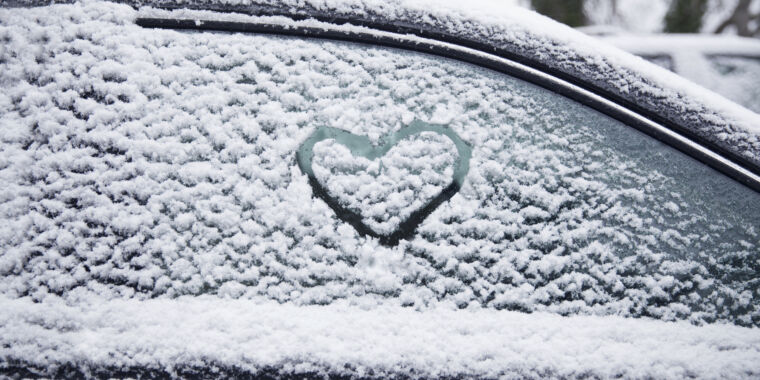Getty Images
Objectively speaking, a battery-electric vehicle provides a superior driving experience in cold and inclement weather to its internal combustion engine-powered counterparts—for numerous reasons. Comfort, control, even durability benefits come along for the cold ride. Let me explain.
First, actually, let me concede a point. It’s true that BEVs lose range in colder climates. The two main reasons for that stem from the need to keep both the cabin and battery pack warm, which requires energy that would otherwise go toward going. And, generally speaking, it takes more energy to warm an electric vehicle in the winter than to cool it in the summer.
But bear in mind, all cars lose range in the winter. Air gets denser as it cools, which takes more work to push through. And all the viscous fluids vehicles need take more time to warm up to their respective operating temperatures. And that means your engine, transmission, and differential all have more work to do—requiring more energy—in the cold.
Warm the cabin
In fact, BEVs outperform ICE here. Thanks to smaller grille openings and flatter underbodies (no driveshafts or tailpipes to worry about) BEV bodies tend to have lower coefficients of drag and slip through the air with less effort. Moreover, most of the complex parts in a car that require viscous fluids to do not exist in a BEV, i.e., no engine or transmission to worry about.
Furthermore, the very thing that creates the range disadvantage for BEVs also delivers a distinct advantage. Because electric motors operate so much more efficiently, there’s a lot less waste heat to use to warm the cabin. As a result, you get separate electric heating elements that start working as soon as you start your car, heating either your seat or the whole cabin, or both. Ten minutes of shivering as you wait for the engine to warm up is a thing of the ICE past.
And engineers continually work to utilize any waste heat available to warm the cabin and limit battery pack usage. Kevin Cansiani, lead development engineer of the Cadillac Lyriq, says it has something called the Ultium energy recovery system, which connects the battery, drive units, power electronics, and cabin to a heat pump and coolant system. That can then transfer any excess heat from one place to where it’s needed.
“Because we have some bandwidth there, we like to call it an advanced heat pump system,” Cansiani says.
Indeed, Cadillac’s version seems the most elaborate to capture any wasted heat, but many manufacturers offer some kind of heat pump to serve a similar purpose.
Prewarm your car
Speaking of comfort, why even wait to start your BEV to warm it up? If you charge at home, just tell it when you plan to leave and let it preheat the cabin for you, all while still plugged into the charger. You need not worry about tailpipe emissions poisoning you in your garage because there is no tailpipe.
Cansiani told me the Lyriq can do this three different ways: with the My Cadillac App, the remote cabin conditioning on the key fob, or set it up with the center console touchscreen ahead of time.
“Say you start driving to work at 6:30 am,” Cansiani says. “It’ll start charging at a specific time [the night before] and then also have reserve energy to make sure that everything is conditioned: the car, the battery, the cabin, which you specify [ahead of time] as part of those settings. And then, essentially, the car is waiting for you at that temperature at that time in the morning.”
See what I mean? More convenience and comfort in the cold weather.
Furthermore, even with a drop of driving range in the cold, modern battery packs usually offer at least 250 miles (402 km) of range in ideal conditions. The Lyriq, for example, offers between 307-314 miles (494-505 km) of range, according to the EPA, depending on trim and drivetrain. Even if it’s extremely cold and you lose half of your range (you almost certainly won’t) that still leaves you over 150 miles (241 km), plenty for anything other than a road trip or full day as an Uber driver.


